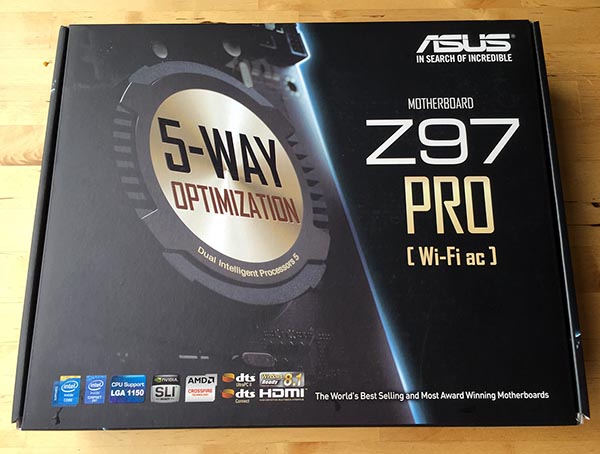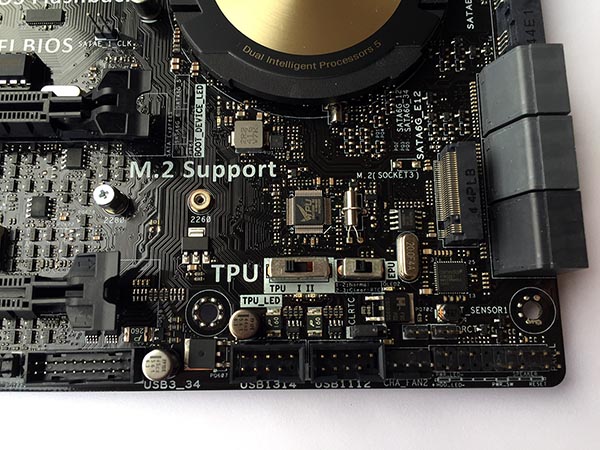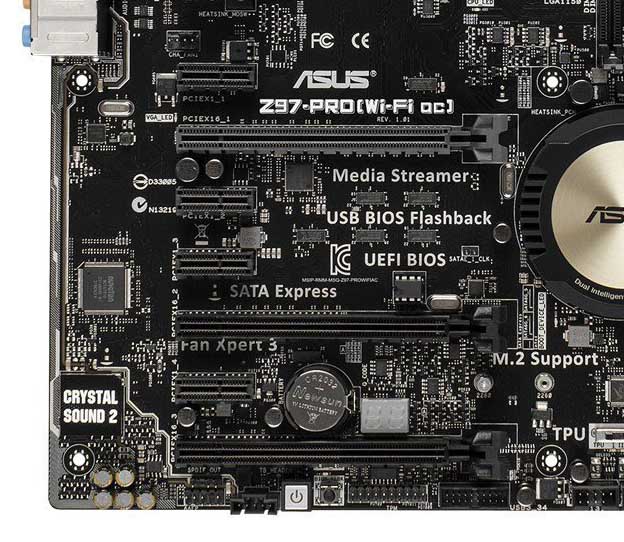Asus Z97 Pro (Wi-Fi ac) Socket 1150 Motherboard Review
Layout and Features
Taking a tour around this ATX board, the first thing we noticed is that although ASUS is keeping the gold and black color scheme it began using on the Z87 chipset boards, the company has toned it down a bit for Z97 and, dare we say, it looks "classy" now. We thought the previous version was a bit gaudy, so kudos to Asus for attempting to fix something a lot of customers were unhappy about.
Moving onto the board itself, the specs are fairly standard as they are exactly the same as what we saw with Intel's Z87 chipset, so most of this should be quite familiar to anyone who has built a rig in the past few years. Starting at the top we see four color-coded RAM slots that support up to 32GB of dual-channel DDR3-3200 overclocked memory (OC), and the slots have tabs on just one side to make installation easier and prevent any damage to long graphics cards. Just above the memory slots there is an EZ XMP switch for one-flick enabling of XMP, as well as a MemOK button in case memory issues are preventing you from booting.The CPU socket gets two four-pin PWM fan headers along with one more fan header just above the 24-pin PSU connector.
Moving around the edge of the motherboard, just below the 24-pin PSU connector we have a front-panel USB header, then the star of the show in some ways —the SATA Express Port. Though there are few drives currently on the market that support this PCI Express interface, it could for allow up to 10Gb/s transfers, so its inclusion is welcome. That said, it's quite possible the market will go in a different direction entirely, either with M.2 or using a PCI Express add-on card, so its possible this port will go unused for the life of the board. Luckily you can still use its two adjacent SATA ports if you are so inclined.
The Z97 Chipset supports 10Gb/s SATA Express - maybe one day a drive will plug into this bad boy?
Next to the the SATA Express port we see six SATA 6Gb/s ports, four of which use the onboard Intel controller (grey), and two that run off an ASMedia controller (black). Directly behind the SATA ports is the M.2 port, which shares PCI Express lanes with the SATA Express port, so you can run one or the other, but not both. If you're not going to install a SATA Express drive (at some point in the future), you can also just use the two SATA ports as well.
At the bottom of the board is a TPU switch that will let the system automatically adjust the CPU clock speed and ratio for "optimal" performance. There's an EPU switch next to it that when enabled tries to optimized power consumption. Two internal USB ports reside on the bottom of the board along with a TPM header and a Thunderbolt header that fits an add-on card. There's a physical power button which is useful for testing, as well as a BIOS flashback button that lets you flash the BIOS without entering the BIOS or powering up the system. While we understand the convenience of not having to power on the system to flash the BIOS, we're so paranoid when flashing our BIOS that we shut off our phone, hold our breath, and clench our sphincter when it's updating, so we'll pass on using this feature.
On the far edge we see the Crystal Sound 2 emblem, indicating the presence of the Realtek ALC1150 audio codec with PCB separation for improved audio. In terms of PCI Express lanes, the board supports three-way SLI and CrossFire via PCI Express (PCI-E x8 with more than two cards) but you won't be using three cards on this board as the bottom x16 slot defaults to x1 mode since it shares bandwidth with the PCIe x1 directly above it and one of the USB 3.0 headers. The manual says the motherboard supports Quad-SLI, but there are only three full-length PCI-E slots, so we imagine this is possible if you are running two dual-GPU cards but it's not possible to run four single-GPU cards on this motherboard. The two upper slots are PCI Express 3.0 x16, and they run at full speed with one card in the slot, or at x8 speed when two cards are used. There are also four PCI-e x1 slots.
The I/O area is a bit minimal in that there are only four USB 3.0 ports, two USB 2.0 ports, and four video outputs including HDMI, DisplayPort, VGA, and DVI. There is one Intel Gigabit LAN connector, a PS/2 port for those kicking it old school, audio connectors, and the antenna connectors for receiving or sending a Wi-Fi signal.

The bundle for this motherboard includes an I/O shield, four SATA cables, one SLI connector, the Wi-Fi antenna and a Q-Connector for plugging in the chassis power leads to the motherboard.












